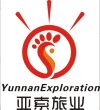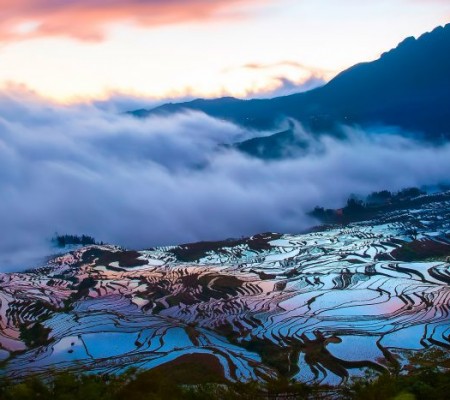
Qiliang Village of Jinshan Town in Gucheng District, Lijiang
Geographical Location
Qiliang Village(启良村) is located in Liangmei Village Committee, Jinshan Town, Gucheng District, Lijiang City. It is situated in the southeast of Gucheng District, bordering Yongsheng County to the east, Qixi River to the south, Xianghe Office to the west, and Dadao Township to the north. Serving as the southern gateway to Lijiang City, Qiliang Village is conveniently accessible, just about 10 kilometers away from the urban area of Lijiang. It is an ideal destination to experience the traditional charm of the Naxi ethnic group and enjoy the natural beauty.
Ethnic Groups and Traditional Skills
Ethnic Groups
Qiliang Village is home to several ethnic minorities, including the Naxi, Bai, and Lisu peoples. The Naxi people are the predominant ethnic group here. Known for their hospitality, love for singing, and dancing, the Naxi people offer visitors a rich and authentic ethnic experience.
Traditional Skills
Naxi Traditional Architectural Skills: The traditional Naxi residential buildings in Qiliang Village are well-preserved, characterized by the layout of “three rooms with one screen wall” and “four courtyards with five sky wells.” These buildings, with their simple yet elegant style, reflect the exquisite craftsmanship of Naxi architecture.
Naxi Embroidery: The Naxi embroidery is renowned for its exquisite craftsmanship, vibrant colors, and diverse patterns, holding high artistic value. Visitors can observe the embroidery process by Naxi women and purchase exquisite embroidered handicrafts as souvenirs.
Dongba Culture: The Dongba culture of the Naxi people is recognized as a UNESCO Intangible Cultural Heritage. Dongba script, an ancient pictographic writing system of the Naxi people, is known as a “living pictograph.” In Qiliang Village, visitors can learn about the history and significance of Dongba culture through its writing and transmission.
Customs and Festivals
Customs
Sky Worship: The Naxi people have a unique custom of sky worship. Every year on the fifth day of the first lunar month, a grand ceremony is held at the village’s sky worship site. This is one of the most important rituals of the Naxi people, where villagers gather to pray for favorable weather, abundant harvests, and prosperity.
Festival Dancing: Festival dancing is a traditional group dance activity of the Naxi people, usually held during festivals or important occasions. Villagers form a large circle and dance to the rhythm of music, creating a lively and joyful atmosphere. Visitors are also welcome to join in and experience the Naxi dance culture.
Fire Pit Culture: The fire pit culture is an essential part of Naxi family life. In Naxi households, the fire pit serves as the center of the family, symbolizing warmth and unity. Visitors can visit Naxi families to learn about the significance and role of the fire pit culture.
Festivals
Three Flowers Festival: The Three Flowers Festival is one of the most important festivals of the Naxi people, usually held on the eighth day of the second lunar month. Three Flowers is the protective deity of the Naxi people, and on this day, grand sacrificial activities are held to seek blessings from the deity. The festival features song and dance performances, traditional sports competitions, and other activities, making it a vibrant and festive occasion.
Torch Festival: The Torch Festival is a traditional festival of the Naxi people, usually held on the twenty-fifth day of the sixth lunar month. On this day, people light torches, symbolizing the expulsion of evil and the pursuit of peace. The festival includes bonfire parties, song and dance performances, and other activities, attracting many visitors to enjoy the festivities.
Tourist Attractions
Natural Scenery
Ten Thousand Mu Rhododendron Forest: Surrounding Qiliang Village are vast rhododendron forests. Every spring, rhododendrons bloom in full splendor, covering the mountainsides in a sea of flowers. Visitors can admire the breathtaking beauty of the rhododendrons and experience the charm of nature.
Yu Shui Lake: Located near Qiliang Village, Yu Shui Lake features emerald green waters surrounded by mountains, offering a serene and beautiful scenery. Visitors can take a boat tour on the lake to enjoy the lake views, or camp and have a picnic by the lake, savoring the tranquil natural moments.
Tea Horse Road Relics
Qiliang Village was an important route on the Tea Horse Road, preserving many relics of the mule tracks and caravan inns. Visitors can experience the fun of hiking the Tea Horse Road and feel the historical charm of the ancient route. Along the way, they can also visit old mule inns, tea shops, and other buildings to learn about the commercial culture and muleteer life of the Tea Horse Road.
Transportation
Self-Driving
Starting from the urban area of Lijiang, follow Lining Road to Jinshan Town, and then navigate to Qiliang Village. The total distance is about 10 kilometers, with a driving time of about 15 minutes. The route is scenic and well-maintained, making it the best choice for traveling to Qiliang Village.
Public Transportation
Take a bus from the passenger station in Lijiang City to Jinshan Town. The journey takes about 30 minutes. Upon arrival in Jinshan Town, transfer to a local rural bus or taxi to Qiliang Village, with a travel time of about 10 minutes.
Accommodation and Dining
Accommodation
Qiliang Village offers several traditional Naxi-style guesthouses that provide an authentic ethnic accommodation experience. These guesthouses are beautifully decorated, well-equipped, and reasonably priced. Additionally, Jinshan Town has a selection of hotels and inns with better facilities but slightly higher prices.
Dining
Naxi Specialties: Qiliang Village is home to a variety of Naxi specialties, such as Naxi barbecue, chickpea jelly, and Naxi hot pot. Visitors can enjoy these authentic Naxi dishes at local farmhouses to experience the rich Naxi culinary culture.
Local Snacks: The village also has many snack stalls offering traditional Naxi snacks, such as rice cakes, rice intestines, and flower cakes. These snacks are unique in flavor and reasonably priced, making them worth trying.
Travel Tips
Best Travel Time: Qiliang Village is suitable for travel all year round. Spring (March to May) is the season when rhododendrons bloom; summer (June to August) is cool and refreshing; autumn (September to November) offers pleasant scenery; and winter (December to February) is the time to experience traditional Naxi festivals.
Cultural Experience: Respect local customs and actively participate in folk activities. Engage in friendly exchanges with local residents to gain a deeper understanding of the Naxi culture and lifestyle.
Environmental Protection: Qiliang Village boasts beautiful natural scenery. Visitors are encouraged to protect the environment by not littering, cherishing plants and trees, and preserving natural resources.
Safety Tips: When hiking the Tea Horse Road, pay attention to safety and choose appropriate routes and gear. If necessary, hire a local guide to ensure a safe and smooth journey.

 7 Days GolfingTour
7 Days GolfingTour
 8 Days Group Tour
8 Days Group Tour
 8 Days Yunnan Tour
8 Days Yunnan Tour
 7 Days Shangri La Hiking
7 Days Shangri La Hiking
 11 Days Yunnan Tour
11 Days Yunnan Tour
 6 Days Yuanyang Terraces
6 Days Yuanyang Terraces
 11 Days Yunnan Tour
11 Days Yunnan Tour
 8 Days South Yunnan
8 Days South Yunnan
 7 Days Tea Tour
7 Days Tea Tour
 8 Days Muslim Tour
8 Days Muslim Tour
 12 Days Self-Driving
12 Days Self-Driving
 4 Days Haba Climbing
4 Days Haba Climbing
 Tiger Leaping Gorge
Tiger Leaping Gorge
 Stone Forest
Stone Forest
 Yunnan-Tibet
Yunnan-Tibet
 Hani Rice Terraces
Hani Rice Terraces
 Kunming
Kunming
 Lijiang
Lijiang
 Shangri-la
Shangri-la
 Dali
Dali
 XishuangBanna
XishuangBanna
 Honghe
Honghe
 Kunming
Kunming
 Lijiang
Lijiang
 Shangri-la
Shangri-la
 Yuanyang Rice Terraces
Yuanyang Rice Terraces
 Nujiang
Nujiang
 XishuangBanna
XishuangBanna
 Spring City Golf
Spring City Golf
 Snow Mountain Golf
Snow Mountain Golf
 Stone Mountain Golf
Stone Mountain Golf




